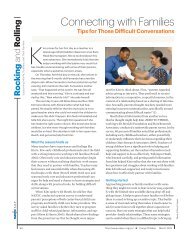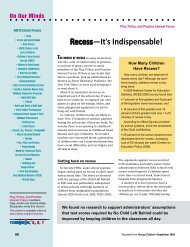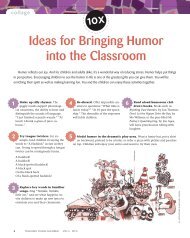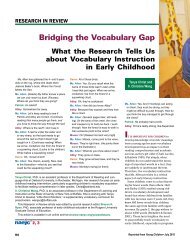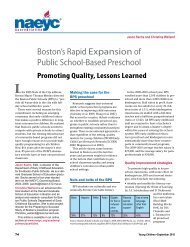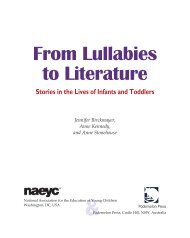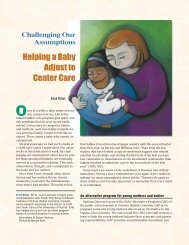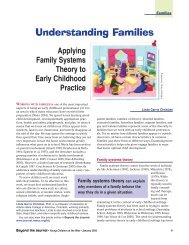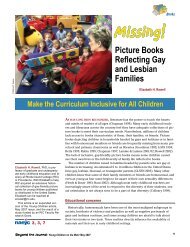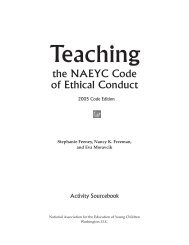The Power of Documentation - National Association for the ...
The Power of Documentation - National Association for the ...
The Power of Documentation - National Association for the ...
You also want an ePaper? Increase the reach of your titles
YUMPU automatically turns print PDFs into web optimized ePapers that Google loves.
<strong>The</strong> <strong>Power</strong> <strong>of</strong> <strong>Documentation</strong><br />
in <strong>the</strong><br />
Early Childhood<br />
Classroom<br />
A parent eyes something on <strong>the</strong> wall in <strong>the</strong><br />
hallway near her child’s classroom. She stops<br />
and looks across <strong>the</strong> entire wall, as if trying to<br />
determine where to start. She moves to <strong>the</strong> left<br />
a bit and scans <strong>the</strong> bulletin board posted far<strong>the</strong>r<br />
down. At one point she nods as if in agreement<br />
and mouths a yes. Ano<strong>the</strong>r parent approaches and turns<br />
to see what is on <strong>the</strong> wall. He too is mesmerized by <strong>the</strong><br />
documentation <strong>of</strong> what one child discovered about pussy<br />
willows by using an I-scope lens.<br />
EARLY CHILDHOOD EDUCATORS<br />
might ask, “What is documentation?”<br />
or “Is this documentation?” <strong>The</strong>y<br />
sometimes wonder, “Can my bulletin<br />
board be documentation?”<br />
What is documentation?<br />
Knowing what is documentation is<br />
<strong>the</strong> first stage <strong>of</strong> understanding <strong>the</strong><br />
process. Katz and Chard <strong>of</strong>fer this<br />
explanation: “<strong>Documentation</strong> typically<br />
includes samples <strong>of</strong> a child’s work at<br />
several different stages <strong>of</strong> completion:<br />
photographs showing work in progress;<br />
comments written by <strong>the</strong> teacher<br />
®<br />
2, 3, 4<br />
or o<strong>the</strong>r adults working with <strong>the</strong><br />
children; transcriptions <strong>of</strong> children’s<br />
discussions, comments, and explanations<br />
<strong>of</strong> intentions about <strong>the</strong> activity;<br />
and comments made by parents”<br />
(1996, 2).<br />
Effective communication<br />
Hilary Seitz<br />
An effective piece <strong>of</strong> documentation<br />
tells <strong>the</strong> story and <strong>the</strong> purpose <strong>of</strong> an<br />
event, experience, or development.<br />
It is a product that draws o<strong>the</strong>rs into<br />
<strong>the</strong> experience—evidence or artifacts<br />
that describe a situation, tell a story,<br />
and help <strong>the</strong> viewer to understand <strong>the</strong><br />
purpose <strong>of</strong> <strong>the</strong> action.<br />
Hilary Seitz, PhD, is <strong>the</strong> early childhood coordinator in <strong>the</strong> Department <strong>of</strong> Teaching and<br />
Learning at <strong>the</strong> University <strong>of</strong> Alaska in Anchorage. Her wide range <strong>of</strong> early childhood<br />
experiences includes teaching in child care centers, a public preschool, and elementary<br />
schools. hilary@uaa.alaska.edu<br />
When used effectively, consistently,<br />
and thoughtfully, documentation can<br />
also drive curriculum and collaboration<br />
in <strong>the</strong> early childhood classroom<br />
setting.<br />
Formats that work<br />
A bulletin board can be a <strong>for</strong>m <strong>of</strong><br />
documentation, but <strong>the</strong>re are any<br />
number <strong>of</strong> o<strong>the</strong>r possible <strong>for</strong>mats,<br />
including a presentation board containing<br />
documentation artifacts and/<br />
or evidence (documentation panels),<br />
class books, portfolios, slide shows,<br />
movies, and o<strong>the</strong>r creative products.<br />
<strong>The</strong> <strong>for</strong>mat that documentation<br />
takes can be as varied as <strong>the</strong> creator’s<br />
mind permits. Because documentation<br />
should provide evidence <strong>of</strong> a process<br />
with a purpose, whatever <strong>the</strong> <strong>for</strong>mat,<br />
it should fully explain <strong>the</strong> process,<br />
highlighting various aspects <strong>of</strong> <strong>the</strong><br />
experience or event.<br />
88 Young Children • March 2008
Audience and purposes<br />
Successful documentation<br />
<strong>for</strong>mats reflect <strong>the</strong> intended<br />
audience and purposes. In<br />
addition, <strong>the</strong> <strong>for</strong>mat selected<br />
will depend on <strong>the</strong> individual<br />
preparing <strong>the</strong> documentation<br />
and how <strong>the</strong> children are<br />
involved in <strong>the</strong> experience.<br />
For example, if one teacher<br />
wants to highlight <strong>for</strong> families<br />
and administrators how <strong>the</strong><br />
class is meeting a particular<br />
math or science standard, she<br />
would use examples <strong>of</strong> children<br />
participating in experiences<br />
that align with <strong>the</strong> standard.<br />
As evidence, she might<br />
include photographs <strong>of</strong> children<br />
measuring plant stems<br />
with a ruler, children’s comments<br />
about measuring <strong>the</strong><br />
stems, background in<strong>for</strong>mation<br />
about how <strong>the</strong> children<br />
learned about measurement<br />
To stay on track, carefully<br />
select one topic<br />
and explore it to <strong>the</strong> fullest<br />
ra<strong>the</strong>r than trying to<br />
do a little <strong>of</strong> everything.<br />
(or plants), and <strong>the</strong> specific learning<br />
standard <strong>the</strong><br />
children are<br />
meeting by<br />
participating<br />
in this experience.<br />
To best<br />
combine all <strong>of</strong><br />
<strong>the</strong>se elements,<br />
<strong>the</strong> teacher<br />
may choose a<br />
documentation<br />
panel as <strong>the</strong><br />
<strong>for</strong>mat to help<br />
<strong>the</strong> audience<br />
understand<br />
how children<br />
are learning.<br />
<strong>Documentation</strong><br />
Artifacts and Evidence<br />
• Teacher’s description and overview <strong>of</strong> an event/<br />
experience/skill development, such as photographs and<br />
descriptions <strong>of</strong> a field trip<br />
• Photographs <strong>of</strong> children at work—<strong>for</strong> example, conducting<br />
a science experiment<br />
• Samples <strong>of</strong> children’s work, like a writing sample from<br />
<strong>the</strong> beginning <strong>of</strong> <strong>the</strong> year<br />
• Children’s comments, such as “All <strong>the</strong> rocks have sparkles<br />
in <strong>the</strong>m,” in writing or as recorded by <strong>the</strong> teacher<br />
• Teacher or parent comments about a classroom<br />
event—<strong>for</strong> instance, “It was really fun helping <strong>the</strong> children<br />
measure <strong>the</strong> ingredients <strong>for</strong> playdough”<br />
• Teacher transcriptions <strong>of</strong> conversations during small<br />
group time when children are exploring a new topic,<br />
such as why snow melts indoors<br />
• Important items or observations relating to an event/<br />
experience/development, such as “Johnny can now write<br />
his own name on his work”<br />
If children in <strong>the</strong> class are <strong>the</strong><br />
intended audience, however, and <strong>the</strong><br />
purpose <strong>of</strong> <strong>the</strong> documentation is to<br />
help children reflect on <strong>the</strong>ir math and<br />
science learning and connect <strong>the</strong>m to<br />
future lessons, <strong>the</strong>n <strong>the</strong> teacher would<br />
select different artifacts and evidence.<br />
A documentation panel could again<br />
be appropriate, but different artifacts<br />
and evidence might include a web <strong>of</strong><br />
children’ s ideas: <strong>for</strong> instance, why an<br />
Possible Topics to Document<br />
• Individual child growth and development, such as language development<br />
progression<br />
• Expected behaviors (at group time, in using a certain toy, while eating toge<strong>the</strong>r)<br />
• Curriculum ideas or events (field trips, presentations, special activities,<br />
celebrations)<br />
• Curriculum projects, such as learning about plant life cycles<br />
• Families and relationships (different types <strong>of</strong> family structures and characteristics<br />
<strong>of</strong> <strong>the</strong> families in <strong>the</strong> classroom community)<br />
• Evidence <strong>of</strong> meeting learning standards (by posting work samples)<br />
• Questions and answers <strong>of</strong> <strong>the</strong> children, teachers, and families about such topics<br />
as classroom routines (like how to wash your hands)<br />
elephant should not live at<br />
<strong>the</strong> Alaska Zoo, children’s<br />
comments about <strong>the</strong><br />
elephant, and questions <strong>for</strong><br />
fur<strong>the</strong>r exploration, such as,<br />
“Where should an elephant<br />
live?” Add related photographs<br />
and work samples.<br />
Again, an explanation<br />
about where <strong>the</strong> learning<br />
began and where it is<br />
intended to go will help any<br />
audience better understand<br />
<strong>the</strong> documentation. In both<br />
cases, <strong>the</strong> quality <strong>of</strong> <strong>the</strong> end<br />
product will depend on <strong>the</strong><br />
teacher’s understanding <strong>of</strong><br />
children, <strong>the</strong> curriculum, and<br />
<strong>the</strong> standards, along with his<br />
or her effective use <strong>of</strong> technology<br />
and observation.<br />
What should we<br />
document?<br />
A variety <strong>of</strong> experiences<br />
and topics are appropriate to<br />
document, but documentation should<br />
always tell a complete story. To stay<br />
on track, carefully select one topic<br />
and explore it to <strong>the</strong> fullest ra<strong>the</strong>r<br />
than trying to do a little <strong>of</strong> everything.<br />
For example, if <strong>the</strong> class is learning<br />
about plants (and studying plant<br />
parts, how to grow particular plants,<br />
types <strong>of</strong> plants, and so on), it would<br />
be best to document fully just one<br />
aspect <strong>of</strong> children’s<br />
learning.<br />
Choosing a<br />
focus<br />
<strong>The</strong> teacher<br />
might choose to<br />
document only<br />
<strong>the</strong> children’s<br />
study <strong>of</strong> plant<br />
parts, <strong>for</strong> example,<br />
and could<br />
start by providing<br />
a learning<br />
spark, such as<br />
a new plant in<br />
Young Children • March 2008 89
<strong>the</strong> classroom (Seitz 2006). As children<br />
comment on <strong>the</strong> plant parts, <strong>the</strong><br />
teacher can create a web to record<br />
what <strong>the</strong>y know and to help <strong>the</strong>m<br />
<strong>for</strong>mulate questions. <strong>The</strong> children<br />
might also draw and label <strong>the</strong> various<br />
plant parts.<br />
Presenting <strong>the</strong> topic<br />
and learning<br />
<strong>The</strong> teacher can combine all <strong>of</strong><br />
<strong>the</strong>se pieces to make a documentation<br />
panel. This panel would illustrate <strong>the</strong><br />
children’s knowledge and understanding<br />
more thoroughly than a panel<br />
displaying every child’s worksheet<br />
on plant parts, all <strong>of</strong> <strong>the</strong>ir watercolor<br />
paintings <strong>of</strong> a plant, and every<br />
brainstormed list <strong>of</strong> vegetable plants.<br />
Offering specific examples <strong>of</strong> how<br />
children came to <strong>the</strong>ir understandings<br />
about just one aspect <strong>of</strong> a lesson—in<br />
this case, plant parts—achieves more<br />
than <strong>of</strong>fering an overview <strong>of</strong> several<br />
experiences.<br />
Showing developmental<br />
progress<br />
One important and common topic<br />
<strong>for</strong> documentation is individual child<br />
growth and development. As previous<br />
examples have shown, <strong>the</strong> documenter<br />
is a researcher first, collecting as<br />
much in<strong>for</strong>mation as possible to paint<br />
a picture <strong>of</strong> progress and outcomes.<br />
Documenting individual growth<br />
requires a great deal <strong>of</strong> research, as<br />
<strong>the</strong> teacher must observe each child<br />
in a variety <strong>of</strong> areas <strong>of</strong> development<br />
(such as social-emotional, cognitive,<br />
language, and motor) over a substan-<br />
<strong>The</strong> documenter is a<br />
researcher first, collecting<br />
as much in<strong>for</strong>mation as<br />
possible to paint a picture<br />
<strong>of</strong> progress and outcomes.<br />
tial length <strong>of</strong> time. Only <strong>the</strong>n can <strong>the</strong><br />
teacher create a documentation piece<br />
that tells an accurate story about each<br />
child.<br />
A teacher should be careful to avoid<br />
displaying private or confidential<br />
in<strong>for</strong>mation in public <strong>for</strong>ums. <strong>The</strong>re<br />
are times when documentation may<br />
be more appropriately shared in<br />
o<strong>the</strong>r, more private venues, such as a<br />
portfolio.<br />
Portfolios used <strong>for</strong> individual<br />
assessment <strong>of</strong> children make a particularly<br />
good <strong>for</strong>mat <strong>for</strong> documenting<br />
developmental progress. Teachers<br />
select several domains to research.<br />
<strong>The</strong>y <strong>the</strong>n collect evidence <strong>of</strong> a<br />
child’s interaction with o<strong>the</strong>r children<br />
(photographs and written observations),<br />
record <strong>the</strong> child’s reflections<br />
about <strong>the</strong>ir friendships and cognitive<br />
abilities in interviews or group discussions,<br />
collect work samples, and tie<br />
<strong>the</strong> documentation toge<strong>the</strong>r by writing<br />
a narrative describing <strong>the</strong> child’s<br />
abilities (not deficits) in <strong>the</strong> selected<br />
domains. Even though <strong>the</strong> portfolio<br />
focuses on a child’s abilities, teachers<br />
may want to consider sharing <strong>the</strong><br />
documentation/portfolio in a private<br />
setting, such as a parent/child/teacher<br />
conference, so that parents do not feel<br />
compelled to compare <strong>the</strong>ir child to<br />
o<strong>the</strong>rs in <strong>the</strong> class.<br />
Why should we document?<br />
<strong>The</strong>re are several important reasons<br />
<strong>for</strong> using documentation in early childhood<br />
classrooms.<br />
Showing accountability<br />
Accountability is one reason <strong>for</strong><br />
documentation. Teachers are accountable<br />
to administrators, families,<br />
community members, and o<strong>the</strong>rs,<br />
and documentation helps to provide<br />
evidence <strong>of</strong> children’s learning. In<br />
addition, documentation can improve<br />
relationships, teaching, and learning.<br />
Use <strong>of</strong> this tool helps educators get to<br />
know and understand children, and<br />
it allows <strong>the</strong>m to reflect on <strong>the</strong> effectiveness<br />
<strong>of</strong> <strong>the</strong>ir teaching practices<br />
(Kroeger & Cardy 2006).<br />
Extending <strong>the</strong> learning<br />
Consider <strong>the</strong> following example <strong>of</strong><br />
how one thoughtful teacher could use<br />
documentation to prolong and extend<br />
an unexpected learning opportunity. A<br />
group <strong>of</strong> children finds some miscellaneous<br />
nuts and bolts on a playground,<br />
and <strong>the</strong>ir teacher, noting <strong>the</strong>ir curiosity,<br />
carefully observes <strong>the</strong>ir responses<br />
and listens to and documents <strong>the</strong>ir<br />
90 Young Children • March 2008
conversations (by using written<br />
notes, photographs, and video).<br />
She listens to learn what <strong>the</strong><br />
children know about <strong>the</strong> items<br />
and what <strong>the</strong>y wonder, such as<br />
“Where do <strong>the</strong>se come from?”<br />
<strong>The</strong>n she facilitates a conversation<br />
with <strong>the</strong> children to learn<br />
more about <strong>the</strong>ir ideas and<br />
<strong>the</strong>ories behind <strong>the</strong> purpose <strong>of</strong><br />
<strong>the</strong> nuts and bolts and how <strong>the</strong>y<br />
came to be on <strong>the</strong> playground.<br />
Later <strong>the</strong> teacher incorporates <strong>the</strong><br />
initial comments, <strong>the</strong> photographs,<br />
and <strong>the</strong> conversations in a documentation<br />
source (panel, notebook,<br />
<strong>Power</strong>Point, or o<strong>the</strong>r creative product).<br />
<strong>The</strong> children and teacher revisit<br />
<strong>the</strong> encounter through <strong>the</strong> documentation<br />
and reflect on <strong>the</strong> experience,<br />
which helps <strong>the</strong> children continue<br />
<strong>the</strong>ir conversation and drives <strong>for</strong>ward<br />
<strong>the</strong>ir interest. This back-and-<strong>for</strong>th<br />
examination <strong>of</strong> <strong>the</strong> documentation<br />
helps <strong>the</strong> teacher and children negotiate<br />
a curriculum that is based on <strong>the</strong><br />
children’s interests (Seitz 2006).<br />
Making learning visible<br />
When expected to provide evidence<br />
that children are meeting learning<br />
standards, documentation is a natural<br />
way to make learning visible. Helm,<br />
Beneke, and Steinheimer (1998) call<br />
this idea “windows on learning,” meaning<br />
that documenting <strong>of</strong>fers an insight<br />
into children’s development and learning.<br />
Moreover, <strong>the</strong>y observe, “When<br />
teachers document children’s learning<br />
in a variety <strong>of</strong> ways, <strong>the</strong>y can be more<br />
confident about <strong>the</strong> value <strong>of</strong> <strong>the</strong>ir<br />
teaching” (1998, 24).<br />
How should we document?<br />
<strong>The</strong> documentation process is best<br />
done in collaboration with o<strong>the</strong>r<br />
teachers, parents, and, in some cases,<br />
children soon after <strong>the</strong> experience.<br />
<strong>The</strong> in<strong>for</strong>mation and product become<br />
richer when two or more teachers,<br />
children, and parents work toge<strong>the</strong>r to<br />
understand an event. Collaboration<br />
<strong>The</strong> documentation process<br />
is best done in collaboration<br />
with o<strong>the</strong>r teachers, parents,<br />
and, in some cases, children<br />
soon after <strong>the</strong> experience.<br />
also helps build a classroom community,<br />
which is important because it engages<br />
teachers, parents, and children in<br />
thinking about <strong>the</strong> process <strong>of</strong> learning.<br />
When two or more people discuss<br />
an event, each brings a different perspective<br />
and a new level <strong>of</strong> depth.<br />
<strong>The</strong> photo below shows two teachers<br />
discussing a possible change to <strong>the</strong><br />
classroom environment. <strong>The</strong>y have<br />
discussed aspects that are necessary<br />
and that work and things <strong>the</strong>y would<br />
like to change based on <strong>the</strong> children’s<br />
needs, such as repositioning <strong>the</strong><br />
furniture. Toge<strong>the</strong>r <strong>the</strong>y share how<br />
<strong>the</strong>y have observed young children<br />
using <strong>the</strong> space. This environment<br />
plan would look very different if just<br />
one individual had created it. Carlina<br />
Rinaldi discusses this notion <strong>of</strong> working<br />
toge<strong>the</strong>r and building community:<br />
“To feel a sense <strong>of</strong> belonging, to be<br />
part <strong>of</strong> a larger endeavor, to share<br />
meanings—<strong>the</strong>se are rights <strong>of</strong> everyone<br />
involved in <strong>the</strong> educational process,<br />
whe<strong>the</strong>r teachers, children, or<br />
parents . . . working in groups is essential”<br />
(1998, 114).<br />
Stages <strong>of</strong> <strong>the</strong> documenter<br />
First and <strong>for</strong>emost, documentation<br />
is a process that is learned, facilitated,<br />
and created in stages. I would even<br />
go so far as to say that documenters<br />
go through <strong>the</strong>ir own stages as <strong>the</strong>y<br />
learn more about documenting and<br />
using documentation to support <strong>the</strong>ir<br />
ideas. Many early childhood educators<br />
already document children’s development<br />
and learning in many ways, and<br />
most communicate a variety <strong>of</strong> messages<br />
in diverse <strong>for</strong>mats to families<br />
(Brown-DuPaul, Keyes, & Segatti 2001).<br />
<strong>The</strong>re are six stages that most early<br />
childhood educators, including college<br />
students and practicing teachers,<br />
move through both individually<br />
and collaboratively (see “Stages <strong>of</strong><br />
Documenter Experience”). Educators<br />
who collaborate to learn more about<br />
documentation tend to have more<br />
positive experiences than those who<br />
work on <strong>the</strong>ir own.<br />
Young Children • March 2008 91
Conclusion<br />
Stage<br />
1. Deciding to document<br />
2. Exploring technology use<br />
3. Focusing on children’s<br />
engagement<br />
4. Ga<strong>the</strong>ring in<strong>for</strong>mation<br />
5. Connecting and telling<br />
stories<br />
6. Documenting decision<br />
making<br />
<strong>Documentation</strong> can be a rewarding<br />
process when educators understand<br />
<strong>the</strong> value associated with collecting<br />
evidence and producing a summary<br />
presentation, whe<strong>the</strong>r in a bulletin<br />
board, panel, video, or o<strong>the</strong>r <strong>for</strong>mat.<br />
To become a documenter, one must<br />
first understand what to observe<br />
and what to do with <strong>the</strong> in<strong>for</strong>mation<br />
collected. It takes time and practice<br />
to learn which experiences support<br />
Stages <strong>of</strong> Documenter Experience<br />
Experience<br />
Documenters ask, “What should I document?” <strong>The</strong>y<br />
collect artwork from every child but at first tend to<br />
create busy bulletin boards with too much in<strong>for</strong>mation.<br />
Concerned with equity, many include every item<br />
ra<strong>the</strong>r than being selective.<br />
Documenters explore how to use equipment and<br />
photographs from various events and experiences.<br />
Most <strong>of</strong> <strong>the</strong> photos are displayed on bulletin boards<br />
or inserted in photo albums. <strong>The</strong> video clips are<br />
placed in slideshows or movies and shown to children<br />
and parents.<br />
Documenters learn to photograph specific things<br />
and events with <strong>the</strong> intent <strong>of</strong> capturing a piece <strong>of</strong> <strong>the</strong><br />
story <strong>of</strong> children engaged in learning.<br />
Documenters title <strong>the</strong> photographs, events, and<br />
experiences and begin to write descriptions that tell<br />
<strong>the</strong> story <strong>of</strong> children’s learning.<br />
Documenters combine work samples, photographs,<br />
descriptions, and miscellaneous in<strong>for</strong>mation in support<br />
<strong>of</strong> <strong>the</strong> entire learning event. <strong>The</strong>y tell <strong>the</strong> whole<br />
story with a beginning, middle, and an end, using<br />
supporting artifacts.<br />
Documenters frame questions, reflect, assess, build<br />
<strong>the</strong>ories, and meet learning standards, all with <strong>the</strong><br />
support <strong>of</strong> documentation.<br />
effective documentation and how to<br />
collect artifacts and evidence.<br />
Next, as documenters learn why <strong>the</strong><br />
in<strong>for</strong>mation is important, <strong>the</strong>y begin<br />
to understand <strong>the</strong> value <strong>of</strong> documentation<br />
<strong>for</strong> different audiences and come<br />
92 Young Children • March 2008<br />
Value<br />
Documenters show pride in <strong>the</strong><br />
children’s work.<br />
Documenters work hard to<br />
learn more about technology.<br />
<strong>The</strong>y show pride in <strong>the</strong> children’s<br />
actions by displaying<br />
photos and video clips.<br />
Documenters become technologically<br />
competent and able<br />
to focus on important learning<br />
events and experiences.<br />
Documenters begin to connect<br />
children’s actions and<br />
experiences.<br />
Documenters continue to use<br />
documentation artifacts to connect<br />
children’s actions and<br />
experiences to curriculum and<br />
learning standards.<br />
Documenters become reflective<br />
practitioners who document<br />
meaningful actions/events,<br />
explain why <strong>the</strong>y are important,<br />
and push <strong>the</strong>mselves and o<strong>the</strong>rs<br />
to continue thinking about<br />
<strong>the</strong>se experiences.<br />
to recognize why certain aspects <strong>of</strong><br />
child development are important<br />
to assess. In addition, documenters<br />
learn that administrators and parents<br />
value this in<strong>for</strong>mation, yet it also has<br />
value to <strong>the</strong> children and <strong>the</strong> teacher<br />
Often <strong>the</strong> documentation provides insights into chil-<br />
dren’s thinking and helps drive <strong>the</strong> future curriculum.
in planning au<strong>the</strong>ntic curriculum that<br />
meets children’s needs.<br />
Finally, <strong>the</strong> documenter learns<br />
how best to interpret and display<br />
<strong>the</strong> in<strong>for</strong>mation ga<strong>the</strong>red. Often <strong>the</strong><br />
documentation provides insights into<br />
children’s thinking and helps drive <strong>the</strong><br />
future curriculum. Deepening children’s<br />
learning is <strong>the</strong> ultimate reward<br />
<strong>of</strong> documentation.<br />
References<br />
Brown-DuPaul, J., T. Keyes, & L. Segatti. 2001.<br />
Using documentation panels to communicate<br />
with families. Childhood Education 77<br />
(4): 209–13.<br />
Helm, J.H., S. Beneke, & K. Steinheimer. 1998.<br />
Windows on learning: Documenting young children’s<br />
work. New York: Teachers College Press.<br />
Katz, L.G., & S.C. Chard. 1996. <strong>The</strong> contribution<br />
<strong>of</strong> documentation to <strong>the</strong> quality <strong>of</strong> early<br />
childhood education. ED 393608. www.ericdigests.org/1996-4/quality.htm<br />
Kroeger, J., & T. Cardy. 2006. <strong>Documentation</strong>: A<br />
hard-to-reach place. Early Childhood Education<br />
Journal 33 (6): 389–98.<br />
Rinaldi, C. 1998. Projected curriculum construction<br />
through documentation—Progettazione.<br />
In <strong>The</strong> hundred languages <strong>of</strong> children:<br />
<strong>The</strong> Reggio Emilia approach—Advanced<br />
reflections, 2nd ed., eds. C. Edwards, L. Gandini,<br />
& G. Forman, 114. Greenwich, CT: Ablex.<br />
Seitz, H. 2006. <strong>The</strong> plan: Building on children’s<br />
interests. Young Children 61 (2): 36–41.<br />
Fur<strong>the</strong>r resources<br />
Chard, S.C. 1998. <strong>The</strong> Project Approach: Making<br />
curriculum come alive. New York: Scholastic.<br />
Curtis, D., & M. Carter. 2000. <strong>The</strong> art <strong>of</strong> awareness:<br />
How observation can trans<strong>for</strong>m your<br />
teaching. St. Paul, MN: Redleaf.<br />
Edwards, C., L. Gandini, & G. Forman, eds.<br />
1998. <strong>The</strong> hundred languages <strong>of</strong> children: <strong>The</strong><br />
Reggio Emilia approach—Advanced reflections.<br />
2nd ed. Greenwich, CT: Ablex.<br />
Fraser, S., & C. Gestwicki. 2002. Au<strong>the</strong>ntic childhood:<br />
Exploring Reggio Emilia in <strong>the</strong> classroom.<br />
Albany, NY: Delmar/Thomson Learning.<br />
Fu, V.R., A.J. Stremmel, & L.T. Hill. 2002. Teaching<br />
and learning: Collaborative exploration<br />
<strong>of</strong> <strong>the</strong> Reggio Emilia approach. Upper Saddle<br />
River, NJ: Merrill.<br />
Gandini, L., & C.P. Edwards, eds. 2001. Bambini:<br />
<strong>The</strong> Italian approach to infant/toddler<br />
care. New York: Teachers College Press.<br />
Hill, L.T., A.J. Stremmel, & V.R. Fu. 2005. Teaching<br />
as inquiry: Rethinking curriculum in early<br />
childhood education. Boston: Pearson/Allyn<br />
& Bacon.<br />
Jones, E., & J. Nimmo. 1994. Emergent curriculum.<br />
Washington, DC: NAEYC.<br />
Katz, L.G., & S.C. Chard. 2000 Engaging children’s<br />
minds: <strong>The</strong> project approach. 2nd ed.<br />
Greenwich, CT: Ablex.<br />
Oken-Wright, P. 2001. <strong>Documentation</strong>: Both mirror<br />
and light. Innovations in Early Education:<br />
<strong>The</strong> International Reggio Exchange 8 (4): 5–15.<br />
Reed, A.J., & V.E. Bergemann. 2005. A guide to<br />
observation, participation, and reflection in<br />
<strong>the</strong> classroom. 5th ed. Boston: McGraw-Hill.<br />
Shores, E.F., & C. Grace. 2005. <strong>The</strong> portfolio<br />
book: A step-by-step guide <strong>for</strong> teachers. Upper<br />
Saddle River, NJ: Pearson.<br />
Wurm, J. 2005. Working <strong>the</strong> Reggio way: A<br />
beginner’s guide <strong>for</strong> American teachers. St.<br />
Paul, MN: Redleaf.<br />
Copyright © 2008 by <strong>the</strong> <strong>National</strong> <strong>Association</strong> <strong>for</strong> <strong>the</strong> Education<br />
<strong>of</strong> Young Children. See Permissions and Reprints online at<br />
www.journal.naeyc.org/about/permissions.asp.<br />
Young Children • March 2008 93





